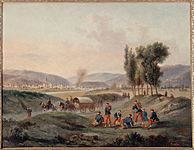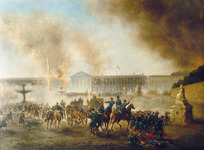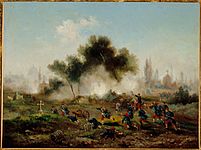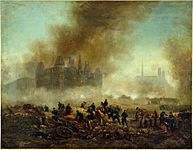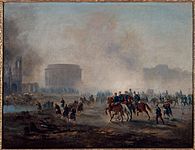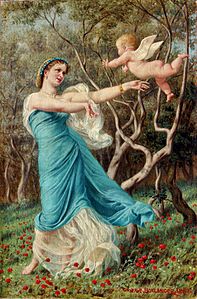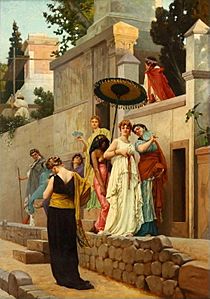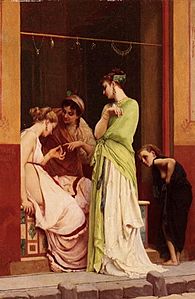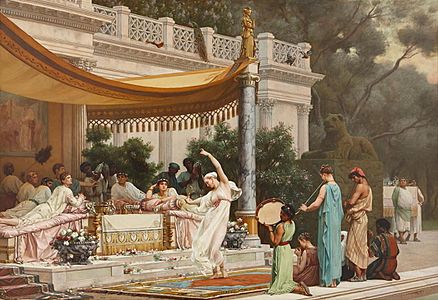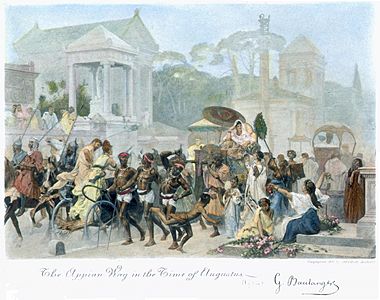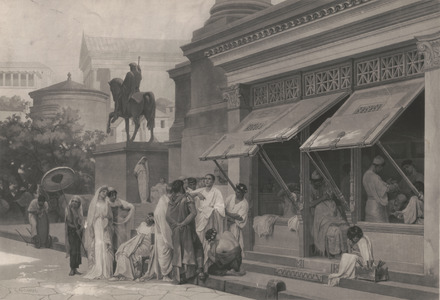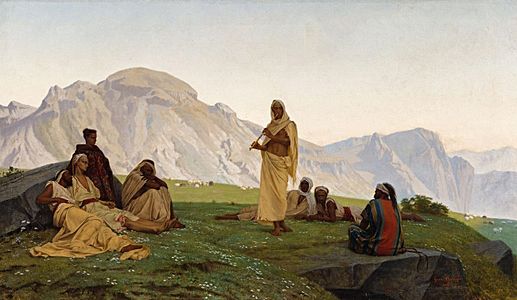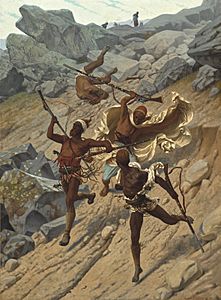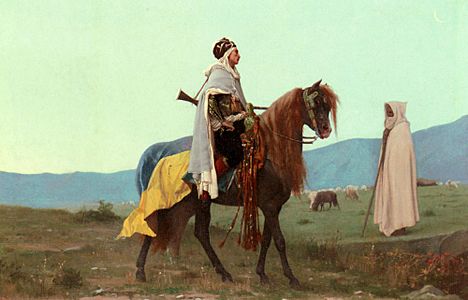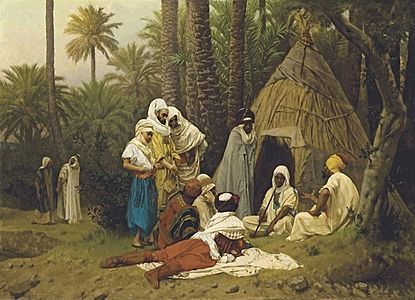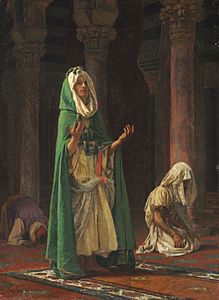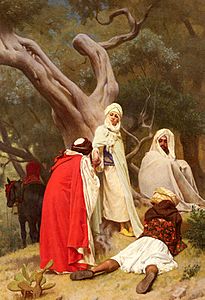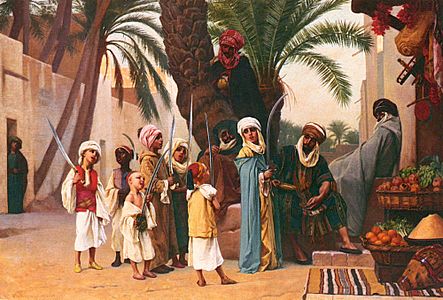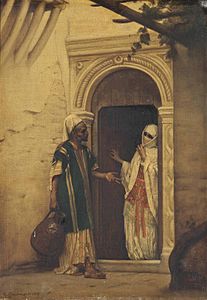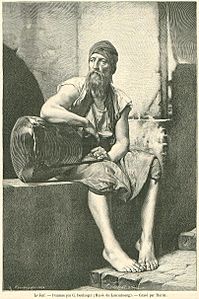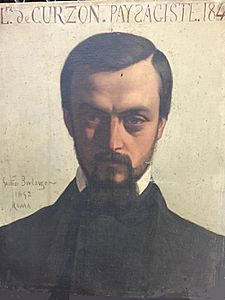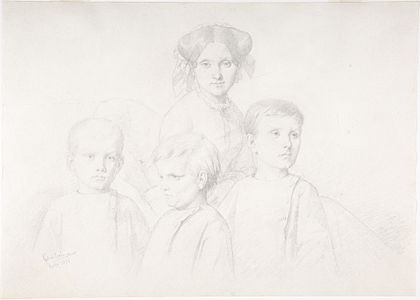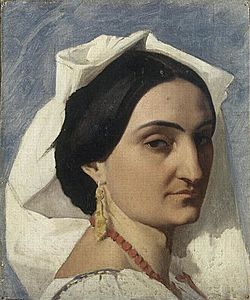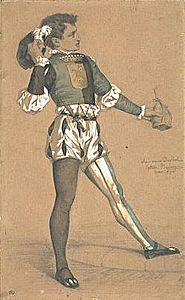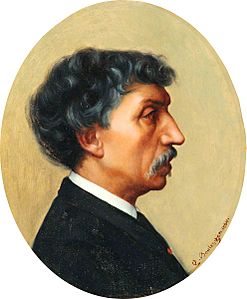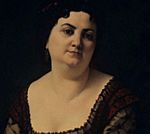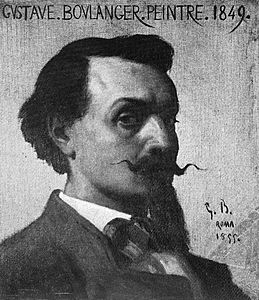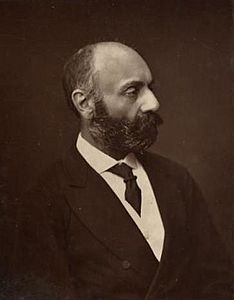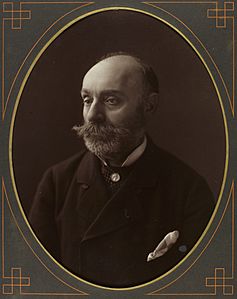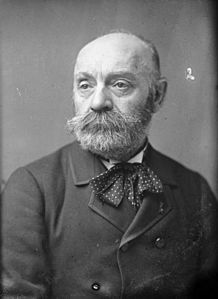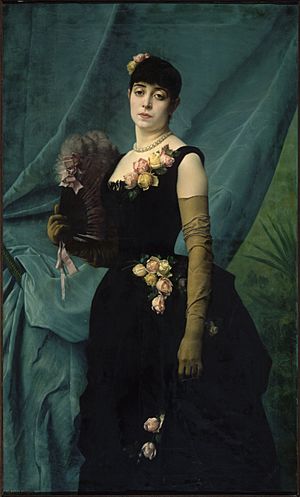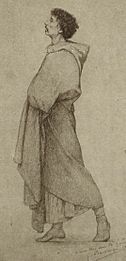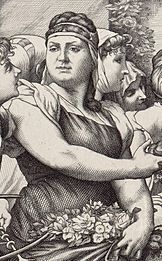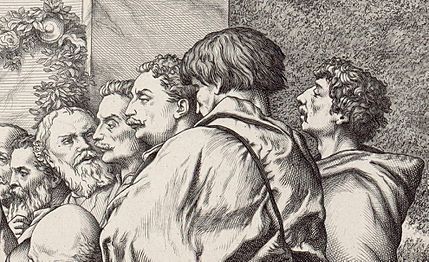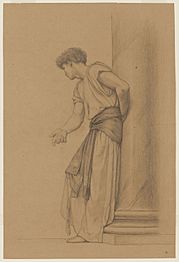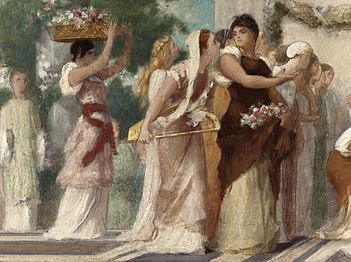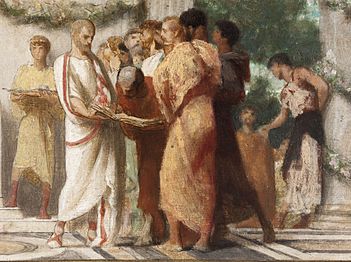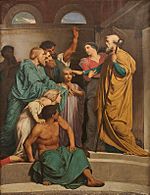Gustave Boulanger facts for kids
Quick facts for kids
Gustave Boulanger
|
|
|---|---|
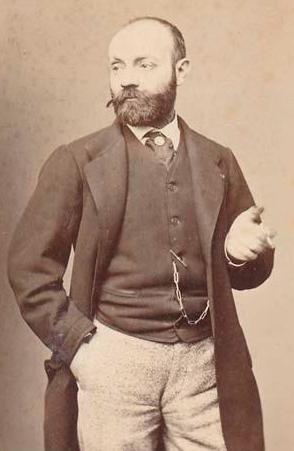 |
|
| Born |
Gustave Clarence Rodolphe Boulanger
25 April 1824 Paris, France
|
| Died | 22 September 1888 (aged 64) Paris, France
|
| Education | Pierre-Jules Jollivet; Paul Delaroche; École des Beaux-Arts, French Academy in Rome |
|
Works
|
Répétition du “Joueur de flûte” et de “La femme de Diomède” chez le prince Napoléon, 1861; Decorative paintings for the Opéra Garnier, 1875; The Slave Market, 1886 |
| Movement | Academic art, Orientalist art |
| Awards | Prix de Rome, 1849; Chevalier of the Legion of Honor, 1865 |
| Signature | |
 |
|
Gustave Boulanger (born April 25, 1824 – died September 22, 1888) was a French painter. He was known for painting people and scenes from history. His art style is called Academic art, which means it followed traditional rules. He also painted many scenes inspired by the Middle East and North Africa, a style known as Orientalist art.
Contents
Gustave Boulanger's Early Life and Training
Becoming an Artist: From Orphan to Art Student
Gustave Boulanger was born in Paris, France, in 1824. He never knew his father. When he was 14, his mother passed away, leaving him an orphan. His uncle, Constant Desbrosses, became his guardian.
In 1840, his uncle sent him to study art. Gustave first learned from a history painter named Pierre-Jules Jollivet. Later, he joined the studio of Paul Delaroche. There, he met and became friends with another student, Jean-Léon Gérôme.
The Néo-Grec Movement and Travel to Algeria
Boulanger and Gérôme became important artists in a group called the Néo-Grec movement. This group loved the art of ancient Greece and Rome. They brought new, sometimes playful, ideas to these classic subjects.
In 1845, Boulanger's uncle sent him to Algeria for business. Gustave was so fascinated by what he saw that his two-month trip turned into eight months! He only returned when his uncle threatened to stop sending money. He brought back many sketches, which he used for his first Orientalist paintings. These paintings showed scenes and people from North Africa and the Middle East. He visited North Africa at least two more times.
Winning the Prix de Rome
Boulanger wanted to win the Prix de Rome, a famous art prize. Winning it meant getting a scholarship to study at the Académie de France à Rome in Italy. In 1848, he won second place with his painting Saint Pierre chez Marie. The next year, he won the Grand Prix with Ulysse reconnu par Euryclée.
He then moved to Rome and stayed there until 1855. During this time, he studied ancient Roman ruins, especially in Pompeii. He also traveled to Greece. Each year, students in Rome sent a painting back to Paris to show their progress. Boulanger's paintings, like Phryné in 1850, often surprised or even shocked the art critics.
After his studies in Rome, Boulanger took another trip to North Africa in 1856. Then he returned to Paris. He opened his own art studio but stayed close with his Néo-Grec friends. His friend Gérôme often asked Boulanger to manage his studio at the École des Beaux-Arts when Gérôme traveled.
Famous Artworks and Projects
The Pompeiian Palace of Prince Napoléon

In 1855, Prince Napoléon Bonaparte, a cousin of Emperor Napoleon III, decided to build a special palace. It was designed to look like an ancient Roman villa from Pompeii. The palace had rooms around an open courtyard with a shallow pool. Statues of the Bonaparte family were placed around the courtyard.
Boulanger's painting, Répétition théâtrale dans la maison d’un poète romain (Theatrical Rehearsal in the House of a Roman Poet), helped inspire this palace.
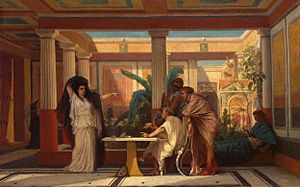
The Pompeiian palace opened in 1860 with a special event. Famous actors performed a play called The Flute Player. Boulanger created a painting to remember this event. His painting, Répétition du "Joueur de flûte" et de la "Femme de Diomède" chez le prince Napoléon, shows a rehearsal, not the actual performance. It includes writers, actors, and a slave.
A writer named Théophile Gautier praised the painting. He said it perfectly blended ancient and modern times, Paris and Pompeii. This painting is seen as a great example of the Néo-Grec style.
Paintings During the Franco-Prussian War
When war came to Paris in 1870, Boulanger joined the National Guard. Many other artists, like Edgar Degas and Édouard Manet, also joined. Life in Paris stopped, and Boulanger painted scenes of the war. These paintings, showing fire and destruction, are very different from his usual work. They are now in the Musée Carnavalet.
Classical and Orientalist Artworks
Boulanger continued to paint scenes from ancient Greece and Rome throughout his career. He was known for his detailed research. One critic called him "a scholar at least as much as a virtuoso." Many of these paintings are in private collections.
Like his friend Gérôme, Boulanger also painted many Orientalist subjects. He got ideas from his trips to North Africa. For a long time, museums preferred his Classical paintings. But today, his Orientalist works are more popular and sell for higher prices.
Portraits and Character Studies
Boulanger also painted and drew portraits throughout his career, though he is less known for them.
-
Camille du Locle, 1854
-
Charles Garnier, 1884
-
Camille Saint-Saëns, 1884
The Slave Market Paintings
Near the end of his life, Boulanger created one of his most famous paintings. It was shown at the Paris Salon in 1886. The painting was called Un Maquignon d’esclaves à Rome (A Slave Dealer in Rome). It is now better known as The Slave Market.
Two years later, in 1888, he painted a companion piece called Esclaves à vendre (Slaves for Sale). This was the last painting he ever showed. These paintings are set in ancient Rome but look more like his Orientalist works. They show a harsh reality, very different from the playful style of his earlier Classical paintings.
The Slave Market is believed to be in a private collection. The location of Esclaves à vendre is unknown.
Boulanger as a Teacher and Art Supporter
Boulanger was a very important teacher. He taught many students, and his influence lasted for a long time.
At the famous Académie Julian, Boulanger taught both male and female students. This was unusual for many teachers at the time. One of his students, Alice De Wolf Kellogg, said he was her favorite teacher. She felt his lessons were simple, broad, and inspiring.
In 1882, Boulanger became a member of the Institut de France. He also joined the faculty at the Beaux-Arts de Paris, a top art school. In his last years, he was a teacher and a strong supporter of Academic art. He believed in its traditional methods. He gave speeches defending this style of art.
In one speech in 1885, called À nos élèves (To Our Students), Boulanger criticized new art styles. He called them "decadent" and "lazy." He mentioned styles like naturalism, impressionism, and luminism. He believed these new styles were not as good as the traditional French art that had made Paris the art capital of the world. He said, "Art must be a chain; it is when it breaks that there is decadence."
In a letter from 1888, Boulanger wrote that he fought against "Modernity" when it was shown by artists who were "clownish pranksters." He believed these new styles would not last.
An obituary written by Eugéne Montrosier said that Boulanger had a strong will. He didn't want to change with the times in French art. But he resisted honestly and fought for what he believed in.
Boulanger's Personal Life
Friendship with Charles Garnier
Boulanger had a long and close friendship with the architect Charles Garnier. Garnier won the Grand Prix de Rome for architecture in 1848. Boulanger won his Grand Prix for art the next year. They met as students in Rome. Boulanger painted several portraits of Garnier over the years.
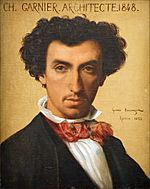
In 1868, Boulanger traveled to Spain with Garnier and his wife. Garnier's travel journal includes some drawings by Boulanger and many sketches of Boulanger by Garnier. One drawing shows Boulanger with a toothache!
The two friends also worked together. Garnier designed two grand opera houses. He asked Boulanger to create large paintings for them. Boulanger's paintings for the Foyer de la Danse in the Opéra Garnier in Paris (1875) and his huge ceiling painting Allegory of Music in the Opéra de Monte-Carlo (1879) were considered some of his best works.
Boulanger and Garnier were very close, almost like family. Boulanger's drawing of Garnier's infant son, Daniel, sleeping, shows this closeness. The child died young, and the drawing later went to the Louvre museum. Boulanger once wrote to Garnier, "Do you know you are the second person in my life in whom have I found an imagination and a heart after my own fashion?" (The first was likely his wife). Boulanger and Garnier died within a year of each other.
Marriage to Mademoiselle Nathalie
Boulanger was married to Zaïre-Nathalie Martel, a very famous French actress known as Mademoiselle Nathalie. She was a legend at the Comedie-Française theater. She was known for a famous argument with the younger actress Sarah Bernhardt. In 1863, Bernhardt's sister accidentally stepped on Mademoiselle Nathalie's dress. Mademoiselle Nathalie pushed the girl, who hit a stone column. Bernhardt then slapped Mademoiselle Nathalie. Because Bernhardt refused to apologize, she had to leave the Comedie-Française.
Mademoiselle Nathalie died in 1885, three years before Boulanger. He gave his portrait of her, painted in 1867, to the Comedie-Française. Records show that the Boulangers did not have children.
Gustave Boulanger's Appearance
Boulanger's self-portrait from when he was around 30 years old shows him with a serious look and a neat mustache. However, later in life, his appearance was quite different from his elegant art. One art historian described him as having a round face, a bald head, a small nose and mouth, and a shaggy beard. Despite this, the historian noted the "delicacy" hidden beneath his "rough bark."
Death and Legacy
On September 21, 1888, Boulanger became ill and died the next day. He was a widower and had no immediate family. He died at home, attended by his housekeeper and two nuns. He had a large funeral attended by many artists and writers. His friends Henri Chapu, Tony Robert-Fleury, and Charles Garnier gave speeches.
Boulanger's long teaching career helped carry his art principles into the next century. However, new art movements like Impressionism were becoming more popular. Boulanger died before these new styles completely took over.
Some critics were harsh after his death. One obituary called him a "very mediocre painter" who "taught better than he painted." It said he lacked originality. However, others, like British critic Marion Spielmann, were more balanced. Spielmann said Boulanger was a "popular" painter who reached a high level of excellence, but not "absolute genius." Spielmann believed Boulanger's decorative paintings, like those in the Opéra Garnier, would keep his reputation alive.
Boulanger was often compared to his friends Gérôme and Alma-Tadema. While Gérôme and Alma-Tadema's art became less popular for a time, it has recently gained interest again. Boulanger's work, especially his Orientalist paintings, has also increased in value in the 21st century. However, his auction records are still lower than Gérôme's.
Boulanger and Gérôme were linked from the start of their careers. One critic called Boulanger "a sort of alter ego of Gérôme's." He felt Boulanger often fit his style to his friend's. However, he also noted that Boulanger could sometimes paint classical scenes with more grace than Gérôme. Boulanger often remains in Gérôme's shadow. No art expert has yet fully studied Boulanger's work on its own merits.
Boulanger's Art in Museums
In Paris Museums
- The Death of Cyrus (study), 1844, École nationale supérieure des beaux-arts.
- Ulysses Recognized by Eurycleia, 1849, École nationale supérieure des beaux-arts.
- Portrait of the Poet and Librettist Camille du Commun du Locle, 1854, Musée du Louvre.
- Rehearsal of "The Flute Player" and "Wife of Diomedes" at Prince Napoléon's Palace (study), 1860, Comédie-Française.
- Rehearsal of "The Flute Player" and "Wife of Diomedes" at Prince Napoléon's Palace, 1861, Musée d’Orsay.
- Daniel Garnier Sleeping (drawing of Charles Garnier's infant son), c. 1862, Musée du Louvre.
- Portrait of Zaïre-Nathalie Martel, known as Mademoiselle Nathalie, 1867, Comédie-Française.
- Saarbrücken After the Battle, c. 1870, Musée Carnavalet.
- The Assault on the Cemetery by Regular Troops, 1871, Musée Carnavalet.
- Episode of the Commune, Place de la Concorde, 1871, Musée Carnavalet.
- The Hôtel de Ville on Fire, Attacked by Versailles Troops, 1871, Musée Carnavalet.
- The Rotunda of La Villette Surrounded by Versailles Troops, 1871, Musée Carnavalet.
- The Saint-Jacques Tower Retaken by Versailles Troops, 1871, Musée Carnavalet.
- Civic Virtues: Marriage, Departure for War, Ancient Life, Study, Family, Forge, 1878, studies for the 13th arrondissement city hall, Petit Palais.
- Portrait of Charles Garnier, date unknown, Bibliothèque nationale de France.
- Various drawings and sketches, Musée du Louvre.
In Other French Museums
- Portrait of Monsieur Sinclair-Desbrosses, 1849, Musée Lambinet.
- Park of the Villa Borghese in Rome, c. 1847, Musée Hébert, La Tronche.
- Ulysses Recognized by Eurycleia (study), 1849, Musée Magnin, Dijon.
- Acis and Galatea, 1848, Musée d'Art et d'Histoire de Narbonne.
- The Meal of the Gods, after Raphael, 1853, Musée des Beaux-Arts de Rennes.
- Head of an Italian Woman, 1854, Musée des Beaux-Arts de Valenciennes.
- Caesar Arriving at the Rubicon (study), 1854, Musée de Picardie, Amiens.
- Caesar Arriving at the Rubicon, 1854, Musée de Picardie.
- Venus Captive, 1860, Musée des Beaux-Arts de Dunkerque.
- The Mamillare (or The Bath; After the Bath), 1867, Musée des Beaux-Arts d'Angers.
- Saint Sebastian and Emperor Maximillian Hercules, 1877, Musée des Beaux-Arts de Marseille.
- Portrait of Madame Lambinet, born Nathalie Sinclair, 1887, Musée Lambinet, Versailles.
In Rome Museums
- Portraits of Boulanger's fellow students at the Académie de France à Rome, Villa Medici: Charles Lecointe, 1849; Jules Duprato and Félix Thomas, 1851; Alfred de Curzon, 1852; Charles Garnier and Jean-Baptiste Gibert, 1854; Adolphe Crauk, Denis Lebouteux, and Boulanger's self-portrait, 1855.
In Netherlands Museums
- Phryné, 1850, Van Gogh Museum, Amsterdam.
In Russia Museums
- Theatrical Rehearsal in the House of a Roman Poet, 1855, Hermitage Museum, Saint Petersburg.
In United Kingdom Museums
- Portrait of Charles Garnier, 1884, Aberdeen Art Gallery.
In United States Museums
- Two Moors, c. 1850, Baltimore Museum of Art.
- Mermaid, date unknown, Baltimore Museum of Art.
- Autumn, 1850, Cleveland Museum of Art.
- Portrait of Woman and Three Children, drawing, 1852, Metropolitan Museum of Art.
Boulanger's Art in Public Buildings
- Decorative paintings for the Foyer de la Danse, Opéra Garnier, Paris, 1875:
- Allegory of Music, ceiling painting above the stage in the Salle Garnier, Opéra de Monte-Carlo, Monaco, 1879.
- Marriage; Study; Homeland; Be a Man; Be a Wife, 1878, in the Marriage Hall of the city hall of the 13th arrondissement of Paris. Boulanger included portraits of people he knew in these large murals. His wife, Nathalie, is a main female figure. Among the wedding guests, you can see his friends and colleagues like Ernest Meissonier, Alexandre Cabanel, Jean-Léon Gérôme, Alexandre Dumas fils, and his closest friend, Charles Garnier. Boulanger also included a self-portrait on the far right.
Boulanger's Art at Auction
The highest price paid for a Boulanger painting was $576,000. This was for The Courtyard of the Palace of Dar Khdaouedj El Amia, Algiers (1877). It was sold at Christie's in New York in 2005.
Other notable sales include:
- $265,250 for El Hiasseub, The Arab Storyteller (1868) in 2009.
- £119,700 for The Prayer (1871) in 2021.
- $66,000 for Catherine I of Russia Negotiating the Treaty of Prut with the Turks (1866) in 2006.
In 1848, as a student, Boulanger submitted a painting for the Prix de Rome. He came in second place. This painting, Saint Pierre introduit dans la maison de Marie, mère de Jean, also called Saint Pierre chez Marie, was thought to be lost for 171 years. It was found in an old house in France. This painting is a rare example of Boulanger's religious art. It was sold at auction in 2019 for €21,000.
See also
 In Spanish: Gustave Boulanger para niños
In Spanish: Gustave Boulanger para niños
- List of pupils of Gustave Boulanger
- List of Orientalist artists
- Orientalism


